Discussion of the golf grip focuses largely on the hands' placement from left to right on the handle – the “strong,” “neutral” and “weak” positions.
What's often lost is how the fingers interact with the club.
Below we'll examine the proper positioning and role of each finger in the grip and the swing. First, a couple of points: 1) Pressure from all 10 fingers should remain constant from the setup through the swing. Most teachers advocate pressure of about 5 on a 1-10 scale. 2) The fingers should not leave the club at any point.
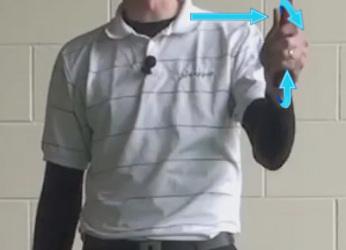
Now, onto the function of each finger. (All references are to right-handed golfers.)
Left Hand
- Pinky and ring fingers: The grip rests at the base of the pinky, which wraps around the handle. The grip crosses slightly higher on the ring finger, between the base and first (bottom) knuckle. These fingers supply the primary pressure of the left hand, particularly the ring finger. It's important not to grip too tightly, however, as this causes tension in the left wrist.
- Middle and index fingers: The grip crosses diagonally, meeting the first knuckle of the middle finger and between the first and second knuckles of the index finger.
- Thumb: Extends down the grip between the fingertips and palm of the right hand. The left thumb pad is the primary contact and pressure point. If the base of the thumb is flush with the handle, you're holding the club too much in the palms.

Right Hand
- Pinky, ring and middle fingers: When using an overlapping or interlocking grip, the right ring finger rests against the left index finger, with the right pinky locked between or lying on top of the gap between the left index and middle fingers. The grip crosses between the base and bottom knuckle of the ring finger and slightly higher on the middle finger.
- Index finger: Also called the “trigger” finger, it plays a key role in the swing. There should be a small gap between the index and middle fingers on the grip's underside, with the index finger hooked around the handle as though squeezing the trigger of a gun. This aids your control and ability to release the club, enhancing feel as well.
- Thumb: Should cross the top of the grip to meet the tip of the right index finger, though it's not necessary for the two to actually touch.
Using a 10-finger or baseball grip, the right pinky will be next to the left index finger.
Get those digits in the right spots, with the right pressure, and you'll have a key fundamental down pat.
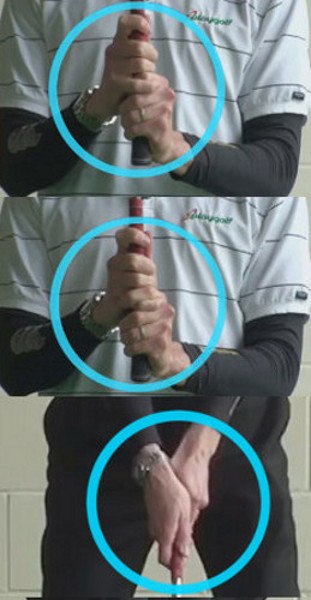
Fingers Play a Key Role in the Golf Swing
You already know that your arms play an important role in the golf swing. The same goes with your legs, your hips, your shoulders, and even your feet. However, have you ever thought about the role that your fingers play in the swing? While it might seem like their only job is to wrap around the grip as the rest of your body swings the club, there is actually far more to it than that. Using your fingers properly won't solve all of your swing problems, but it can take you a step closer to consistent ball striking.
A good golf swing is all about details. The golfer who is willing to pay attention to even the smallest of details is the player who will be able to gradually improve their scores over time. If you don't want to invest the time or effort in refining the small details of your swing, you shouldn't expect to see significant improvement. Even minor changes to your technique can have major consequences to the ball flights that you are able to create.
The role of your fingers certainly can be classified as one of the 'small details' in your swing. Yes, you could easily overlook this part of your swing, and you could still work your way around the course just fine. However, if your fingers are causing problems in your swing and you don't do anything about it, you will be making the game harder than it has to be. And as you know, golf is hard enough even under the best of circumstances.
There is an important distinction that needs to be made between working on elements of your swing on the practice range, and playing golf out on the course. The role of your fingers in the swing is a perfect example of this concept. It is certainly worth your time and effort to learn more about what your fingers should be doing in the swing, but those thoughts should never make their way onto the course. When you are playing a round, you should simply be focused on hitting your targets and executing the swing that you have learned on the practice range. It is very important that practice and on-course play remain separate. Put in your practice time at the range learning things like the role of your fingers in the swing, but set those thoughts aside when it is time to head for the first tee.
All of the instruction below is based on a right handed golfer. If you play left handed, please reverse all of the directions as necessary.
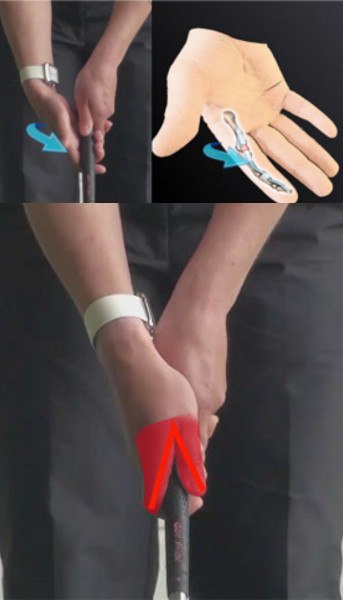
What Do Your Fingers Do During the Swing?
If you have never before thought about your fingers playing a role in the golf swing, you might be a little confused as to what they do to help you hit better shots. Once you grip the club and start the swing, aren't your fingers just along for the ride? Not exactly. While they won't be playing an extremely active role in the swing, they do have a role to play. By making sure your fingers are living up to their end of the bargain in the golf swing, you can take a step closer to playing your best.
The following three points are all important jobs that are handled by your fingers.
- Controlling grip pressure. Good golf swings are relaxed and free – and a big part of swinging with a relaxed tempo is maintaining a light grip pressure. Control of your grip pressure is mainly the job of your fingers, as they are responsible for holding on to the grip as you swing the club back and through. Too much pressure from your fingers will lead to a tight grip, and a lack of rhythm in the swing. However, if you have too little pressure from your fingers, the club will move around in your hands and it may be difficult to make solid contact. Finding an appropriate amount of grip pressure so you can control the club but still swing freely is key to solid ball striking.
- Connecting your hands. You want your hands to work together during the golf swing, but they can only do so when they are connected comfortably and securely. The way you choose to connect your two hands on the grip is up to you – some players prefer to interlock the pinky finger of the right hand with the pointer finger of the left, while others prefer to overlap the former on top of the latter. Either way, you want to have a tight connection that makes your two hands feel more like one throughout the swing. Once you settle on a grip style for your swing, try to stick with it for good, as it is very difficult to change the way you hold on to the club.
- Creating friction. The grip of the golf club should mostly be resting at the base of your fingers during the golf swing, meaning that those fingers are largely responsible for keeping the club in place. In addition to having the right grip pressure, you also want to create a sufficient amount of friction to prevent twisting or sliding of the club during the swing. Most players choose to create friction through the use of a golf club. Putting a glove on your left hand will go a long way toward giving you a better grip. Of course, you don't have to wear a glove, but you do need to make sure that there is enough friction to keep the club in your hands. If you play glove-free, be sure to keep your grips clean and in good condition so you can control the club.
If your fingers aren't doing their job in one of the areas above, your golf swing may be suffering. Ideally, your fingers will be helping you to control the club so you can focus on the other, bigger parts of the swing such as lower body rotation and balance. Should you feel like your fingers are having trouble in one of the areas above, it will be in the best interest of your golf game to correct the problem as quickly as possible.
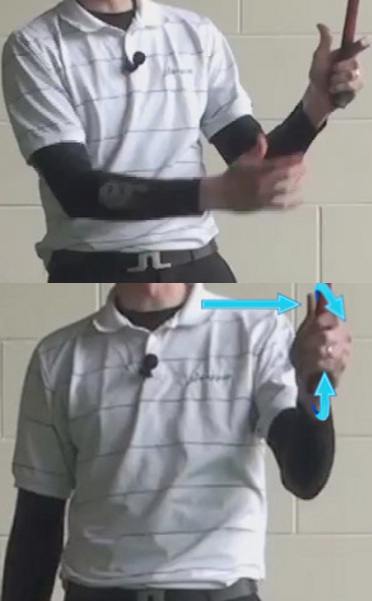
Three Key Fingers
All of your fingers play an important role in the golf swing. However, there are three fingers specifically that you need to make sure are doing their job to help you maximize swing speed – the last three fingers on your left hand. These fingers are holding onto the bottom of the club during the swing, and they need to be firmly affixed to the grip so that you can turn the club head loose at impact. While it is key to have a comfortable grip pressure (as mentioned above), it is okay if these three fingers hold on a little tighter than the rest.
Think of the last three fingers of your left hand as if they were holding on to the end of a whip. As the club swings down from the top of the backswing toward impact, your hands are going to be leading the way. Once your hands have reached the ball, the club will start to uncoil and it will release all of its stored energy into the back of the ball. That is, of course, as long as these three fingers are holding on properly. Without a quality grip at the bottom of your left hand, the club won't be able to release aggressively, and you will lose out on potential swing speed.
To practice using these fingers correctly, try making a few 'dry' swings with only these three fingers on the club. A dry swing is one where you don't actually hit a shot, but simply work on your technique without a ball getting in the way. Take one of your short irons out of the bag and take your stance as you would normally. Once your body is in place, drop your right hand off of the club and put it in your pocket. Then, extend the thumb and pointer finger of your left hand so they are off of the grip as well. With just your last three fingers on the left hand holding the club, go ahead and make a few practice swings. You should instantly feel how important these fingers are to the motion of swinging the club. As long as they hold on tight, you will be free to make an aggressive and confident swing.
If you would like to enhance your feel with this modified grip, head to the practice chipping area to hit a few shots. It will be hard to fully control the club using only three fingers, so just hit short chip shots while doing this drill. Pitch the ball onto the green five or ten times until you start to understand the 'whip-effect' that you can create this way. As you go back to your traditional grip to hit some full shots, keep in mind the feelings that you learned doing this basic drill.
Even though these fingers play a major role in the swing, they shouldn't become blistered as you continue to hit balls and play rounds. The development of a blister is a sign that there is movement between your hands and the grip of the club. Ideally, you would like that connection to be stable throughout the swing. If you notice that you are having problems with blisters developing on your hands – specifically on these three fingers – you should work on your grip technique until you are able to form a better connection between your hands and the grip of the club.
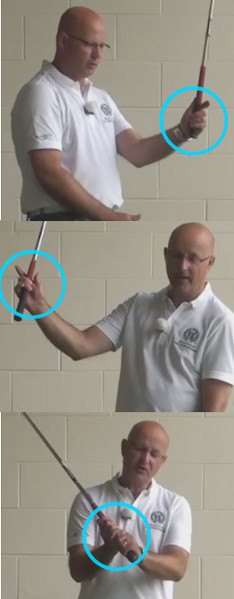
Let Your Fingers Work for You
One of the biggest problems that beginners have when getting started in golf is not taking a proper grip. The grip seems like a basic fundamental, so many new golfers often skip over it in order to work on other, more exciting things. However, getting the grip right is crucial to playing good golf, so every player should take ample time to refine their grip technique.
A common mistake is to put the grip of the club too far up into the palms of the hands instead of placing it at the base of the fingers. Remember, your fingers can help you make a good golf swing, but only if you give them a chance to hold onto the club. If you place the grip too far up into your hands, the club will have trouble releasing freely in the swing. Run the grip along the base of your fingers on both hands to ensure that those fingers are allowed to get involved.
Not all golfers have an easy time learning how to place the grip properly in their hands. If you are struggling to get your fingers involved correctly, try the basic drill below.
- For this drill, you don't need to be at the golf course, and you don't need any golf balls. In fact, you could even do this drill while sitting on your couch, if you so choose.
- Take two of your golf clubs out of your bag for this drill. It doesn't matter which clubs you use, but they should be similar in length. So, for example, don't use your driver and your sand wedge. Driver and three wood or pitching wedge and sand wedge would be better pairs.
- To start, take your left hand grip on one of the clubs. Make sure you position your left hand as you would normally when hitting a golf shot.
- Next, grab the other club with your right hand and place it on top of the first club so that your left hand now has to hold them both. The second club should be in the same position as the first, and the two clubs should be running parallel and touching each other.
- In order to fit both grips in your left hand, you are going to need to push the bottom club down into your fingers. If you have the first club too much in your palm, there simply won't be room for the next club to be added to the grip. To make room, slide the grip of the first club down into the base of your fingers.
- After you have successfully gripped both clubs at the same time in your left hand, remove the second club so you are once again holding just one club. The position of this club should be close to the ideal position for your regular grip.
Feel free to repeat this drill over and over until you are comfortable taking this grip without the use of the second club. As you go forward, your goal should be to have the grip of the club land at the base of your fingers without a conscious thought. With enough repetition, the positioning of the grip will become second nature and you will be able to think about other mechanics while preparing to hit a shot.
There is one other relevant point that needs to be made at this point as well, and it relates to grip size. While you may have gone through the effort to have your clubs fitted for the right shafts, lie angles, lofts, etc., you might not have done the same for your grips. There are a number of different grip sizes available, and you need to make sure you are using the proper grip thickness for your hands. A player with large hands will naturally want to use a thicker grip than a player with small hands, so be sure to customize this part of your set as well. Your equipment should make the game easier, not harder, and properly sized grips will do just that.
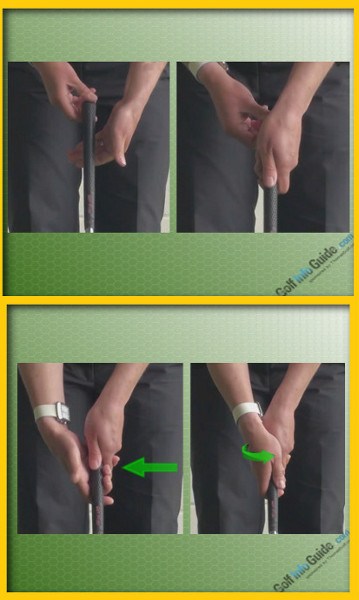
Fingers Take a Back Seat in the Short Game
The short game is all about touch and feel. With that in mind, you may think that your fingers will play an even larger role in the short game than they do in the full swing – but you would be wrong. In fact, just the opposite is true. If you want to reach your potential with the short game, you will keep your fingers out of the action as much as possible.
Stability is key in the short game, and that is one thing that your fingers don't offer. Since you don't need to create speed in your short game swings, there is no need to get your fingers involved in the equation. When hitting full shots, you want your fingers involved because they can help to create the whip that is going to develop all of club head speed. Hitting long drives and powerful iron shots wouldn't be possible without allowing your fingers to play a role in the movement of the club. As you get close to the green, however, that concept goes out the window. Instead, you want to simply control the club as much as possible so you can make solid contact on your putts and chip shots. Power is not required, and therefore, your fingers should stay out of the way.
With the putter, that means you want to run the grip of the club up into your palms and away from the base of your fingers. Basically, you want to take a grip when using your putter than would not work at all when hitting your driver. The grip that you worked on in the drill above placed the grip at the base of the fingers so that you would have plenty of flexibility in your wrists and hands throughout the swing. Of course, on the putting green, the last thing you want is to have flexibility in your hands and wrists. You want those areas to stay as quiet as possible so your shoulders and arms can do the job of moving the club back and through. As you practice your putting, work on forming a grip that runs right up the middle of your palm and your technique will instantly improve.
With chipping, it is a little more complicated. You still don't want to have your fingers too involved in the action, but you can't leave it totally up to your shoulders and arms, either. There needs to be some hand action in your chip shots, so you will need to leave the club down near the base of your fingers just as it was for the full swing. In fact, most golfers will be better off simply using the same grip for all of their shots – with the exception of the putter. Changing your grip is only going to complicate the game, and golf is complicated enough already.
So if you aren't going to change your grip while chipping, how can you keep your hands quiet throughout the stroke? Practice. Plain and simple, you need to practice your chipping motion over and over again until you find exactly the right amount of hand action for you to use. This will vary from player to player, so it isn't something you can copy from another golfer. The only way to determine how much you want to use your fingers while chipping is to hit plenty of practice shots until you discover the right formula for yourself.
Your fingers are probably not the first thing you think about when working on your golf game, but they do play an important role in the overall structure of your swing. While your fingers and hands should stay out of your putting stroke entirely, and play only a limited role in your chipping, they need to be involved in the full swing to generate speed and a clean hit. Use the drills included above to make sure you are using your fingers as effectively as possible within your own swing. By spending even just a few minutes thinking about how you take your grip and how you use your fingers, you stand to improve your golf game.






